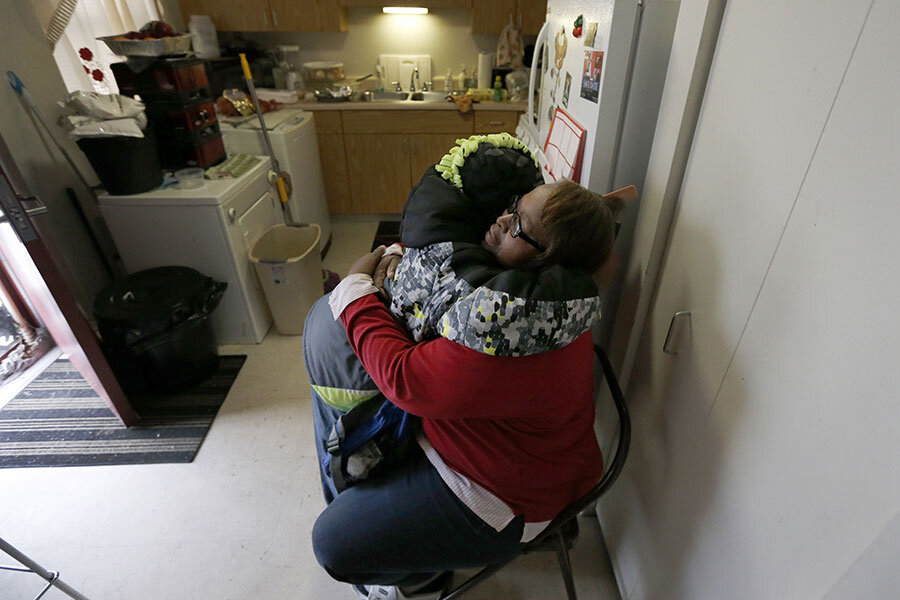More grandparents become caregivers for grandkids. Is that good?
Loading...
More grandparents are becoming caregivers to their grandchildren – an ongoing trend that underscores how America's approach to child care is putting increasing stress on families dealing with a variety of trends, from substance abuse to two-parent working families, experts say.
Census data show that about 2.7 million grandparents in the United States are the primary caregiver for children in their household, up 7 percent from 2009. The figures are part of a new Associated Press report.
While grandparents and other relatives have long played the role of caregiver in many American families, that role has grown more pronounced among the working and middle classes since the Great Recession. Long, irregular working hours for young parents, coupled with the rising costs of professional child care, also transformed grandparents from occasional baby-sitters into a critical safety net for parents with young children.
The situation is characteristic of America's approach to child care – leaving the responsibilities of raising children to parents. But as those responsibilities become more complicated, it is inevitable that many parents will need to turn to the only reliable and cost-effective they can find – their families.
“We don’t have a culture that thinks about children as a national responsibility," says Kathy Simons, an early childhood specialist and senior program manager at the Massachusetts Institute of Technology’s Work-Life Center. "I do think people still think of kids as the responsibility of their direct relations.”
To some, that is as it should be.
"A strong case can be made that parents deserve tax relief to ease the financial strain associated with raising the next generation," writes Carrie Lukas, managing director of the Independent Women's Forum, in an opinion article for The Federalist. "But focusing that support solely on those who use formal daycare programs would be unfair to the millions of parents who have different preferences for their families."
For her part, Dr. Simons worries about the effect that is having on American families.
“We’re expecting families to do too much,” she says. “Child care is a really complicated thing. You don’t solve it once, you solve it six times a month – you have a regular arrangement, a backup arrangement, you have sick days, you have something for trips. You need a bunch of different kinds of arrangements.
Grandparents have increasingly filled many of those roles. In 2008, about 40 percent of grandparents who had grandchildren under age 13 and lived within an hour from them reported providing child care while parents were at work or school, according to the National Association of Child Care Resource & Referral Agencies. Of those, nearly two-thirds said they had grandchildren under 6 years old.
“Child care is expensive, and it’s often not available, especially for lower-income families,” says Elizabeth Peters, director of the Center on Labor, Human Services, and Population at the Urban Institute in Washington. “Often the mother, father, both parents, are working non-standard hours. That’s the advantage of having a grandparent who may be able to provide care during hours when a more formal system is not available.”
There’s also a growing contingent of grandparents who – due to a host of issues, including the growing number of parents struggling with substance abuse or parents away on military deployment – not only provide part-time child care, but are actively raising their grandchildren.
That’s “a whole different ball game,” says Amy Goyer, a family and caregiving expert with the AARP, a national nonprofit that focuses on improving the quality of life of people age 50 and older. “This usually happens when there’s a crisis or chronic problem in the family. There are usually grief and loss issues, [or] the kids have some kind of instability in their life.”
Such situations could have long-term negative impacts on children, families, and society at large, Dr. Peters says. A lack of affordable child care disproportionately affects women’s participation in the labor force – especially among women living at or below the poverty line, she notes.
Research also shows stable environments are critical in early childhood.
“The kind of care we provide our kids can help them develop the early skills and learning that can put them on the right track,” Peters says. “That’s very important, especially for kids coming from disadvantaged backgrounds.”
Initiatives do exist at the state and federal levels, she says. The Department of Health and Human Service’s Head Start program has for decades sought to foster stable family environments for children from low-income homes. Child care subsidies and tax credits also work towards the same goal, Peters says.
Still, some industry experts and advocates say more needs to be done. Simons at MIT, for instance, says enlisting seniors in child care beyond their own grandchildren might be helpful as a way of providing supplementary care that could also be fulfilling for the elderly.
“If we could develop new models for engaging seniors in early education and care; and if the work also got them learning, and kept them mentally active and engaged with other people, that would be fabulous,” she says.
But she and others also would like to see child care made a national priority.
“There are lots of good reasons why family are the best caregivers, but parents should not be forced to rely on grandparents and relatives because they can’t afford any other options,” says Vivien Labaton, co-founder and co-executive director of the Make It Work campaign, a three-year initiative that seeks to improve conditions for working families. “We need to value caregiving in this country.”
Adds Simon: “Grandparents have a really important place to fill in that. But a reliable system of nationally-supported child care has to be a big part of the solution, and we’re a long way from that.”






